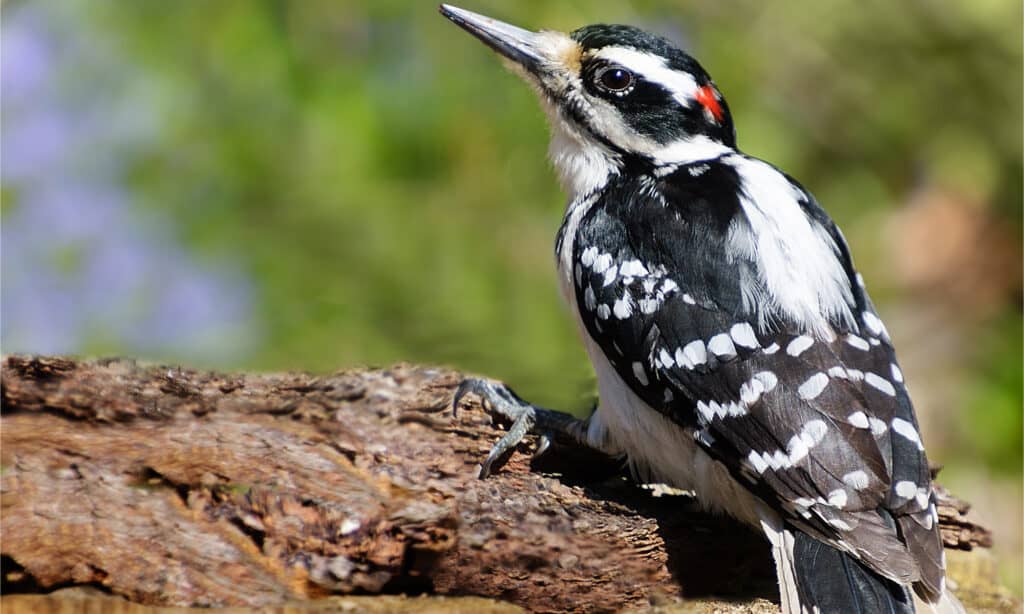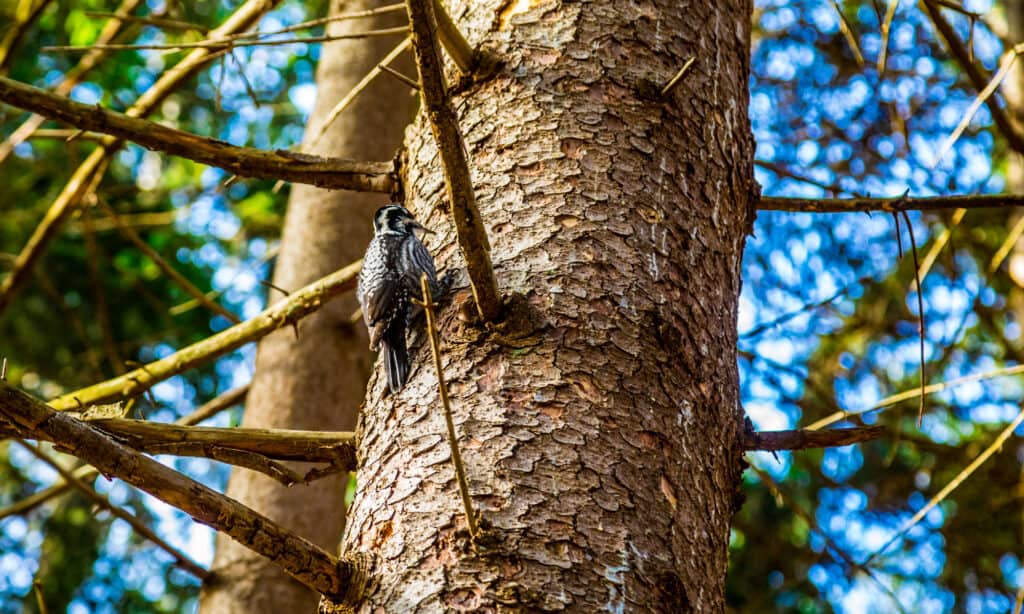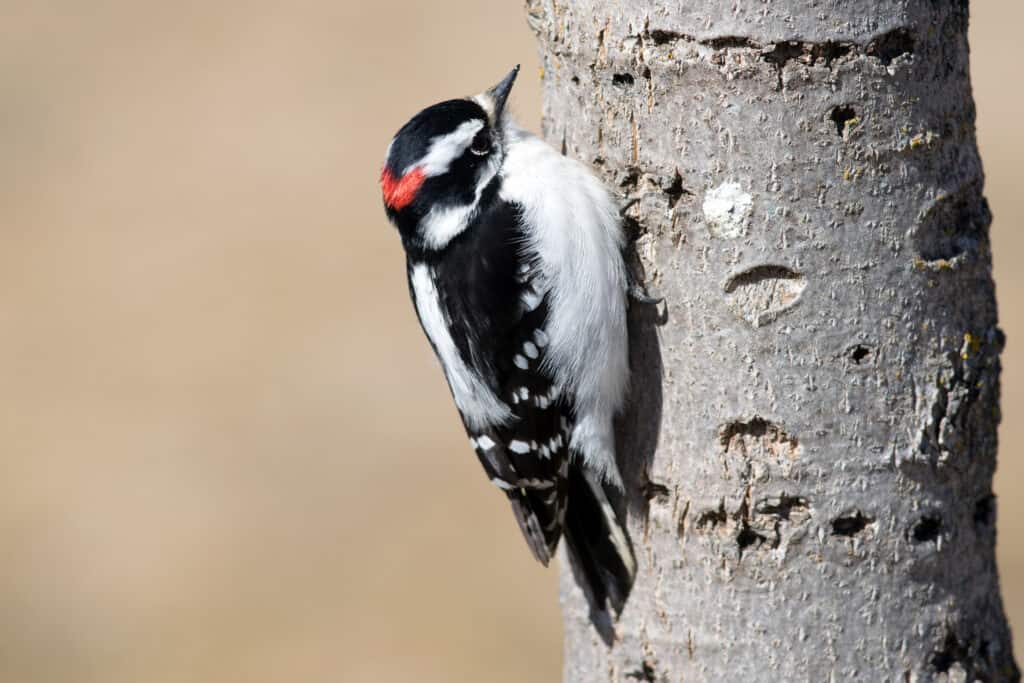Georgia is one of the best states for bird watching. There are many to see and hear. This state is also home to about 8 species of woodpeckers, some more common than others. Throughout this article, we’ll discuss the 8 woodpeckers in Georgia, including fun facts about each and the best places to see them.
1. Red-headed Woodpecker
The first beautiful woodpecker on our list is the red-headed woodpecker. It’s one of the most common woodpecker species in North America. Currently, the red-headed woodpecker is listed as Least Concern on the IUCN Red List. This woodpecker species is mostly found in southern Canada and the central-eastern United States.
Adult red-headed woodpeckers are tri-colored. Female red-headed woodpeckers also have red heads and necks. Young red-headed woodpeckers though have grey heads instead of red. Adults are about 7.5 to 9.8 inches long with a wingspan nearly double that. They are omnivores, but about two-thirds of their diet consists of plants. However, they also consume rodents, insects, and small bird eggs. These lovely birds are almost completely monogamous. Males during breeding season establish a territory and call to find a mate. They then breed with this mate multiple times, raising young together.
In Georgia, you can find red-headed woodpeckers throughout the state. Some great Georgia birding spots are the Kennesaw Mountain National Battlefield Park, Harris Neck National Wildlife Refuge, and Piedmont National Wildlife Refuge.

Red-headed woodpeckers are almost entirely monogamous.
©vagabond54/Shutterstock.com
2. Hairy Woodpecker
Another woodpecker in Georgia is the hairy woodpecker, which is a little larger than the red-headed woodpecker. Hairy woodpeckers are also listed as Least Concern. Experts estimate there are about 9 million hairy woodpeckers in the world. There are about seventeen hairy woodpecker subspecies.
Hairy woodpeckers are about 7.1 to 10.2 inches long, with a maximum wingspan of 17 inches. They vary in weight from 1.4 to 3.4 ounces. These birds are mostly black, white, and grey. However, your male hairy woodpeckers have red on their crowns. Hairy woodpeckers have a wide range and live all over North and South America. You can find them in Nicaragua, the Bahamas, Honduras, Costa Rica, Canada, and the United States.
In Georgia, hairy woodpeckers are found all over, but spend a lot of time in mature deciduous forests. They are most common in areas with dead trees, especially ones that have been burned down.

Hairy woodpeckers are endemic to North America.
©K Quinn Ferris/Shutterstock.com
3. Red-cockaded Woodpecker
Next on our list is the red-cockaded woodpecker. They are endemic to the southeastern United States. Unlike the previous two woodpeckers in Georgia, this species is listed as Near Threatened on the IUCN Red List and Vulnerable through the NatureServe conservation status system. Red-cockaded woodpeckers are small to medium-sized woodpeckers with black and white plumage. However, some males have a small red streak on each side of their black cap more noticeable during breeding season.
Red-cockaded woodpeckers are about 7.1 to 9.1 inches long with a wingspan of up to 16 inches. Interestingly, these birds prefer to forage on large pine trees. They mainly consume insects like beetles, cockroaches, and spiders. However, they also consume berries and nuts. During the breeding season, they partake in cooperative breeding where group members incubate the eggs.

Red-cockaded woodpeckers are a cooperative breeding species and form groups of up to 10 birds.
©Bosko/Shutterstock.com
4. Pileated Woodpecker
You can also find the pileated woodpecker in Georgia. They are large and common North American woodpeckers found in Canada and the United States. These large birds are listed as Least Concern on the IUCN Red List. They are about 16 to 19 inches long and weigh between 7.9 to 14.1 ounces. Probably one of the most impressive features though is their wingspan, which goes up to 30 inches!
Pileated woodpeckers are almost entirely black, except for their red crest, mowhawk, and white lines. You can see their white plumage better when they fly. This woodpecker species mainly lives in old forests and heavily wooded areas, including parks and neighborhoods. A big part of their diet is carpenter ants, but they also eat fruits and nuts. Although they mainly eat insects, they can also consume toxic fruits like poison ivy berries, which don’t affect them. In Georgia, they are found everywhere, but most commonly in heavily wooded suburbs and dead trees.

Pileated woodpeckers are about 16 to 19 inches long and weigh between 7.9 to 14.1 ounces.
©Vlad G/Shutterstock.com
5. Downy Woodpecker
Downy woodpeckers are a small species of woodpecker native to North America. They are actually the smallest species on the continent. The downy woodpecker is only about 5.5 to 7.1 inches long. Most downy woodpeckers weigh less than an ounce but can weigh up to 1.16 ounces. Downy woodpeckers have black and white plumage with a beautiful pattern. They have small black spots on their white tail feathers. Young male downy woodpeckers have a red cap on their heads, while adult males have a red mark on the back of their heads.
Downy woodpeckers mainly live in forests and heavily wooded areas, like other woodpecker species. They prefer dead trees and will nest inside old cavities. Although mainly found in old forests, downy woodpeckers also feed on bird feeders in the winter. If you’re lucky, you may see a downy woodpecker up close feeding!

Some downy woodpeckers weigh less than an ounce. They are the smallest woodpecker species in North America.
©Northernguy/Shutterstock.com
6. Red-bellied Woodpecker
The next woodpecker on our list is the red-bellied woodpecker. Despite their name though, they aren’t just red on their bellies. Red-bellied woodpeckers are members of the Picidae family. They are medium-sized birds that weigh about 2 to 3.2 ounces. Red-bellied woodpeckers are also about 9 to 10.51 inches long. They have grey faces and black-and-white barred patterns. Male red-bellied woodpeckers have red caps on their heads. Females also have red markings but on their napes and a small mark above their bill.
Red-bellied woodpeckers are very vocal birds with many calls. They are also omnivores, mainly consuming arthropods and sometimes flying insects. Although red-bellied woodpeckers search for insects in trees, they also catch them in flight. In Georgia, these birds live in dead or soft live trees. They prefer deciduous forests but are sometimes found in gardens.

As confusing as the red head may be, the red-bellied woodpecker does, in fact, have a red belly.
©rck_953/Shutterstock.com
7. Yellow-bellied Sapsucker
The yellow-bellied sapsucker is a short and stout woodpecker native to parts of North Amerca and Central America. In the United States, they live in the eastern part. Yellow-bellied sapsuckers are listed as Least Concern on the IUCN Red List. They are about 7.5 to 8.25 inches long and weigh between 1.2 to 2.2 ounces. Yellow-bellied sapsuckers have bright red foreheads, although the female heads’ are lighter. Although uncommon, some male yellow-bellied sapsuckers have yellow foreheads. Yellow-bellied sapsuckers also have light yellow bellies that vary in color.
These lovely birds are loud, although males are the loudest, especially during the breeding season. While they sometimes forage in groups during winter, yellow-bellied sapsuckers are generally independent birds. They eat insects, tree sap, fruits, and nuts.

These amazing birds use multiple calls to communicate with each other.
©iStock.com/impr2003
8. Northern Flicker
The last woodpecker on our list of woodpeckers in Georgia is the northern flicker. They are sometimes also called common flickers. Northern flickers are listed as Least Concern on the IUCN. There are many subspecies, broken down into two main groups, yellow-shafted and red-shafted flickers.
Northern flickers are mainly brown and black, but the markings vary depending on the subspecies. Most northern flickers are 11 to 14 inches long and weigh between 3 to 6 ounces. Male northern flickers are best known for their black or red mustachial stripe at the base of their beak. Northern flickers declare territory loudly, by drumming against metal or hard trees. While northern flickers eat fruits and nuts, they mainly consume insects, specifically ants. You may find these lovely woodpeckers on the ground, instead of in trees.

Male northern flickers have a black or red mustachial stripe at the base of their beak.
©FotoRequest/Shutterstock.com
The photo featured at the top of this post is © Benjamin King/Shutterstock.com
Thank you for reading! Have some feedback for us? Contact the AZ Animals editorial team.







